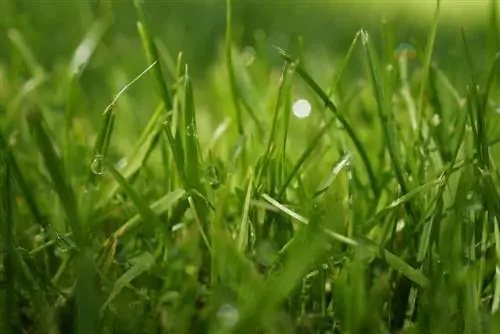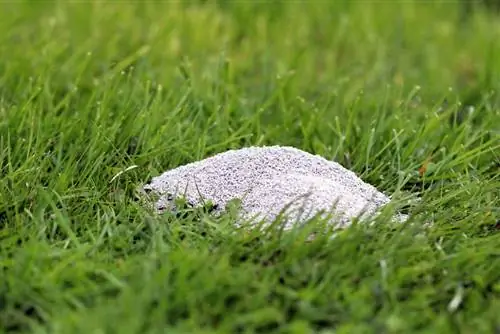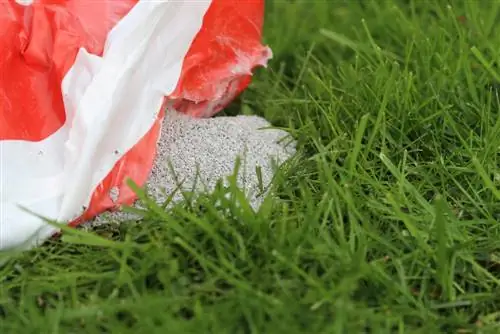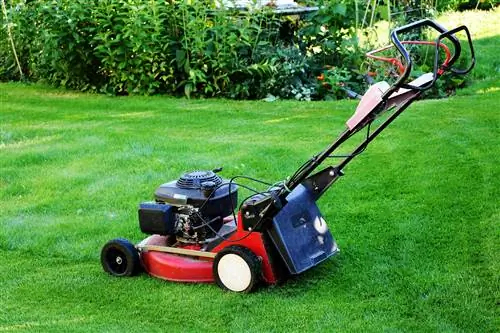- Author admin [email protected].
- Public 2023-12-17 03:39.
- Last modified 2025-01-24 12:45.
If the lawn is lush green and has strong blades, the hobby gardener's heart is happy. To keep it that way, the greenery in the garden should be fertilized regularly. This is a given in spring and summer. However, autumn fertilization is rather unusual in this country. It supplies the blades of grass with important nutrients before the cold season and helps them survive the cold season well.
Features
Special fertilizers, the so-called autumn fertilizers, have a composition that meets the needs of the lawn during the cold season because they are characterized by a high proportion of potassium and phosphate. Potassium acts like a natural antifreeze because potassium increases the s alt concentration in the plant cells, which lowers the freezing point of the plant sap. This makes the stalks more resistant to frost and cold. Phosphate helps the roots survive the cold season well. The autumn fertilizer should also have the following properties:
- high proportion of minerals and trace elements
- good long-term effect
- Minimizing the risk of fungal infection (snow mold)
Under no circumstances should you use a fertilizer that has a high nitrogen content in the fall, as this stimulates the growth of the blades of grass. However, this is counterproductive in autumn because the weather conditions are not optimal for growth. This means that only soft stalks grow back, which are more susceptible to diseases and also do not tolerate frost and cold well.
Time
When is the right time to apply autumn fertilizer depends on the weather conditions and the region. Since the blades of grass only absorb the fertilizer as long as they are growing, grass growth is the decisive criterion when fertilizing. The stalks grow when the temperature is above five degrees Celsius. If it falls below this, it stops growing. Therefore, to determine the optimal time for autumn fertilization, you literally have to put the cart before the horse.
The five degree limit is usually reached in October or November in this country. A look at the temperature history for your region over the last few years will help you narrow down the period more closely. Once it has been clarified, you should allow three to four weeks for the fertilizer to be absorbed. So if the five degree limit is in November, the autumn fertilizer must be applied in October. If it is in October, then autumn fertilization occurs in September.
Tip:
Some also set the growth limit at ten degrees Celsius. In this case, the release of autumn fertilizer will be postponed accordingly.
Temperature drop in autumn
Unfortunately, you can no longer trust the weather, especially in recent years. A cold snap in October and a relatively warm November must be expected. In order to be prepared for such a sudden drop in temperature in October, you can start autumn fertilization earlier, i.e. in September.
Daily weather
In addition to the time on the calendar, you should also pay attention to the weather of the day. Regardless of whether you use a liquid fertilizer or a granular fertilizer, fertilizing should not be carried out on a sunny autumn day. The sun's rays refract the irrigation water and this can cause the blades of grass to burn. This also applies to granular fertilizer, as the lawn must be watered after it has been dispensed.
Take advantage of forecast rain. This means you can apply fall fertilizer if rain is forecast for the next day or in the evening. In this case, the rain does the watering. If you let the rain do the watering, it can take three to four days, depending on the intensity of the rain, for the granules to disappear into the ground. Therefore, a weather situation that promises several days of rain is optimal in this case.
Fertilize
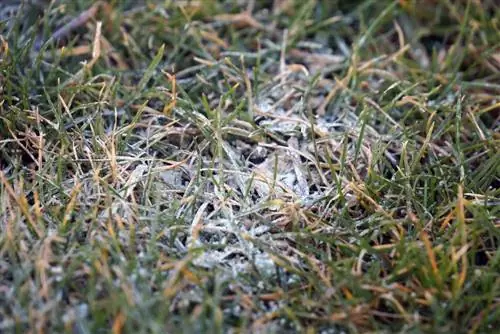
Once the right day has come for autumn fertilization, the greenery must not be over-fertilized. Therefore, you should stick to the amount stated on the bottle or pack. When using a granular fertilizer, you should make sure that the granules are distributed evenly over the lawn. A spreader will help you with this. This means that even paths can be drawn and the granules are distributed evenly over the lawn.
Tip:
Make sure that the tracks do not overlap.
In places that are difficult or impossible to access with the spreader, the granular fertilizer is distributed as evenly as possible by hand. Liquid fertilizers are easier to use because they are simply added to the irrigation water. However, they are only recommended for smaller lawns, as watering large areas can easily become a tedious task.
Patentpotash
Patentpotash, also called potassium magnesia, is a cheap alternative to autumn lawn fertilizers because, like these, it increases the winter hardiness of the lawn. It contains 30 percent potassium, 10 magnesium and 15 percent sulfur. In order for Patentkali to fully develop its effect, it should be administered during the growth phase. This means the lawn can still absorb the fertilizer well. Administration is recommended in September and October. The optimal dose is 70 grams per square meter of lawn area.
Patent potash is distributed in the same way as autumn fertilizers. Here too, you should pay attention to the weather of the day and apply the fertilizer evenly.


